There is a disturbing true story behind the events depicted in The Hammer of Witches, a historical novel by Basque scholar and good friend, Begoña Echeverria, one of my long-time writers. After a brief synopsis, I’ll have Begoña tell that story. (This post first ran in 2014.)
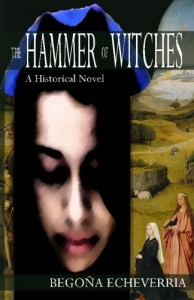 In 1610, a small Basque town is convulsed by accusations of witchcraft. Based on historical events, The Hammer of Witches tells the incredible story of Maria, a girl determined to honor her mother’s memory by learning to read and improve her lot in life; the priest Salvador Zabaleta, who has sworn to protect Maria but whose own identity is beset by struggles; and the mysterious and sophisticated Sabine Elizalde. As Maria is drawn into their lives and into a series of macabre events, she learns about the depths of her own courage. Drawing a nuanced, detailed, rich portrait of early modern Basque society to tell a gripping story of love, betrayal, and sacrifice in a world turned upside down, The Hammer of Witches delves into the dark places of the human spirit and shows that even in the face of tremendous evil, justice can prevail.
In 1610, a small Basque town is convulsed by accusations of witchcraft. Based on historical events, The Hammer of Witches tells the incredible story of Maria, a girl determined to honor her mother’s memory by learning to read and improve her lot in life; the priest Salvador Zabaleta, who has sworn to protect Maria but whose own identity is beset by struggles; and the mysterious and sophisticated Sabine Elizalde. As Maria is drawn into their lives and into a series of macabre events, she learns about the depths of her own courage. Drawing a nuanced, detailed, rich portrait of early modern Basque society to tell a gripping story of love, betrayal, and sacrifice in a world turned upside down, The Hammer of Witches delves into the dark places of the human spirit and shows that even in the face of tremendous evil, justice can prevail.
BURNED AT THE STAKE
In 1610 the Spanish Inquisition prosecuted Basque “witches” for their diabolical crimes: offering children to Satan, partaking in masses and sexual escapades with the devil, feasting on human children, and concocting powders to destroy enemies or their crops. Eleven of those accused refused to confess and were burned at the stake, alive or in effigy. Most were women; few, if any, even spoke the language of their accusers. They spoke Basque, unrelated to Spanish or any other language.
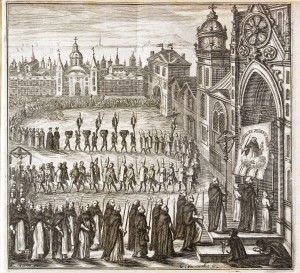
Auto de Fe procession.
A warden of the women’s prison told the Inquisitor that he had overheard its star witness encouraging her aunt to make a false confession, for the only way out of the Secret Prison was to tell the Inquisitors what they wanted to hear. Both aunt and niece were pardoned at the “Auto de Fe” (Act of Faith) ceremony, in which their fellow accuseds were burned. The suspicious circumstances surrounding their confessions were not reported until years later.
They might not have been reported at all were it not for Inquisitor Alonso de Salazar Frías. Though too late to save those burned, he was skeptical about the existence of witchcraft from the start. Just four months before the Auto de Fe, his was the only vote against the death penalty for the eight Basques who continued to deny the charges of witchcraft against them. He recommended they be questioned again under torture instead, this being the only proof the Inquisition would accept of a witch’s innocence. Only two of the deniers were given that chance, a priest and monk, who maintained their innocence despite the torture. Their punishment consisted of exile to monasteries outside Navarre and banishment for life from their home diocese. Their own mothers were not so fortunate: both were burned at the stake alongside two other women and two men in front of 30,000 people.
CREATING A SPECTACLE
People came from all over Spain to witness the spectacle; the Inquisition had advertised the event for days beforehand. King Philip III himself had inquired about the date of the Auto de Fe, but ultimately had been unable to attend.
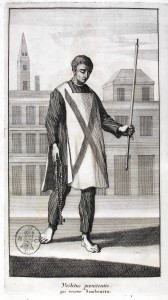
A sambenito with St. Andrew’s cross.
Had he done so, the king might have become as convinced as other spectators as to the reality of the witch-sect, for eighteen Basques confessed to being witches that day. Their confessions were read aloud in the town square, one by one. Each “witch” wore the sambenito (the penitential garment) displaying the St. Andrew’s cross, so that those who could not read or hear the sentences—and the witches themselves, who would not have understood the language of the proceedings—would know they had been welcomed back into the Church. (Or would be, once they paid the usual penance: confiscation of their property and a term of prison or banishment). The reading of the sentences took hours. Reports, pamphlets and even a ballad—unfortunately, long lost—detailed the evil-doings to which the witches had confessed.
These made their way back to the Valley of Baztan, where the accusations of witchcraft flamed anew. Vigilantism ran rampant. Children again accused adults of witchcraft and neighbors turned on one another to root the witches out. Some were subjected to the ladder torture: placed between the rungs of a long ladder and forced to drag it behind them, the trailing end would be lifted up and slammed down, hurling the accused on their faces. Others were tied to a bench, head to toe. The rope would be twisted tighter and tighter with a stick, making breathing difficult and causing excruciating pain. A pregnant woman died this way. Many more lost their lives to other methods of torture, often sanctioned by local authorities.
“CONFESS!”
Alarmed, the Inquisition sent Alonso de Salazar Frías to see what could be done. He was armed with an “Edict of Grace,” translated into Basque, granting clemency to those who confessed to witchcraft within a specified time period. Going to great lengths to protect the identities of those who came forward, Salazar was horrified to learn of what the Inquisition had done to secure confessions. A sixteen-year-old boy had been tied naked to a bed and beaten until he confessed—by his own uncle, an agent of the Inquisition. Other children had been boiled in cauldrons until they confessed. Two sisters told Salazar their father had held a dagger to their throats until they admitted to being witches and named others. An Inquisition official had told the father to do this; if the girls made such a “voluntary” confession, they would not be punished. Still others had been bribed.
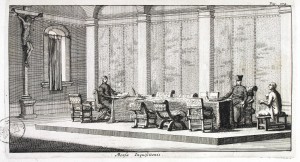
An accused “witch” is grilled by the Inquisition.
Inquisitor de Salazar Frías came to the only logical conclusion: “There were neither witches nor bewitched until they were talked and written about.” And so he put into place an “Edict of Silence,” enjoining people to consult only with Inquisition agents or their parish priest if they “were troubled by their conscience” about witchcraft, so that their suspicions would not become public. In 1617, he reported on the state of affairs among the 1,800 witches supposedly in the area, the 4,000 others suspected of being witches, as well as their dependents and local authorities, all were “in such a state of peace and understanding… that it seems utterly incredible. No one…could have imagined that with the imposition of silence on the witch question it would have been possible to combat the craze to such an extent that today it is as if the problem had never existed.”
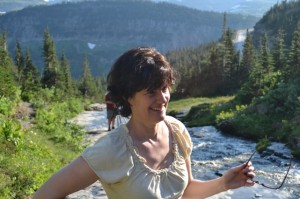
Begoña Echeverria
The daughter of Basque immigrants to California, Begoña Echeverria is a native Basque speaker with a PhD in sociology. A tenured professor at UC Riverside, she has conducted research in the Basque regions of Spain and France since her undergraduate career at Stanford University over twenty-five years ago. A playwright and singer, Begoña has written, recorded and performed songs in Basque—featuring “dangerous” women like witches—in the United States and abroad with her trio, NOKA. She has been interviewed by Vatican Radio and National Public Radio, as well as Basque Country radio stations and publications about her expertise.
The Hammer of Witches is available at Amazon or the Center for Basque Studies, basquebooks.myshopify.com/products/
